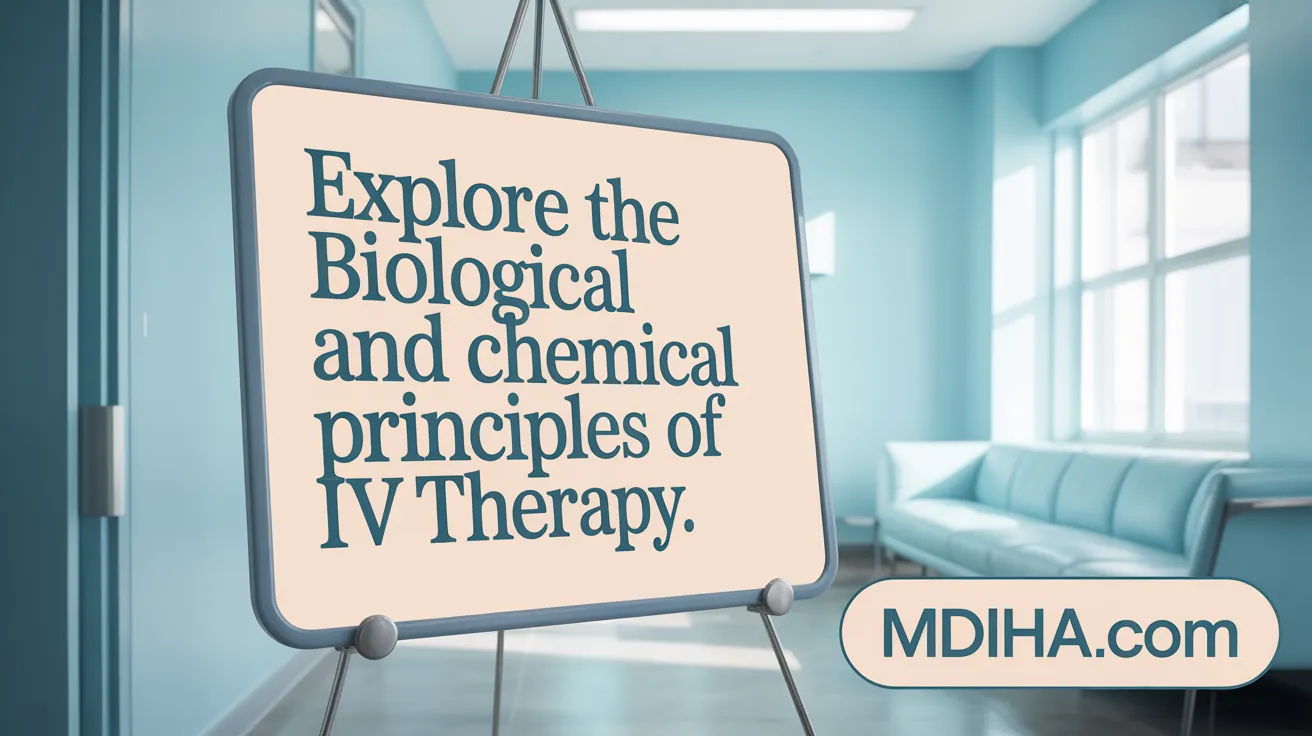Introduction: A New Frontier in Health Optimization
Intravenous (IV) therapy and peptide treatments have surged in popularity as modern approaches to enhancing health, wellness, and targeted disease management. Understanding the science behind these therapies reveals how they leverage biological and chemical principles to deliver rapid and tailored therapeutic effects. This article explores the biomedical foundations, mechanisms, and scientific evidence supporting the effectiveness of IV and peptide therapies, shedding light on their potential to revolutionize healthcare and personal vitality.
Understanding the Biological and Chemical Foundations of IV Therapy

What are the biological and chemical mechanisms behind intravenous (IV) therapy?
Intravenous (IV) therapy involves administering fluids, medications, nutrients, or blood products directly into a patient's bloodstream through a catheter. This method ensures rapid absorption because the substances bypass the digestive system, resulting in almost immediate therapeutic effects. The biological mechanism centers on quickly increasing plasma volume or drug concentration, which allows for swift distribution of these substances across the body.
Chemically, once infused, the substances diffuse into surrounding tissues and interact with specific receptors or molecules to produce their intended effects. For examples, they may support immune health, enhance energy metabolism, promote tissue repair, or restore fluid and electrolyte balance. The type of solution used in IV therapy—whether isotonic, hypotonic, or hypertonic—affects how water and solutes move between the body’s compartments by osmotic principles.
Isotonic solutions, such as normal saline, balance with blood osmolarity, providing effective hydration without shifting fluids between compartments. Hypotonic solutions, like half-normal saline, tend to move water into cells, increasing cellular hydration. Conversely, hypertonic solutions, such as dextrose or saline with high salt concentration, draw water out of cells and into the bloodstream, increasing blood volume.
Understanding these chemical processes and osmotic effects is vital for proper IV therapy, as they influence how fluids distribute and impact cellular function. Proper technique, including aseptic practices, accurate solution selection, and correct infusion rates, is essential to maximize benefits and prevent complications like infections or fluid overload.
How Peptide Therapies Work Within the Body

What is the structure and function of peptides?
Peptides are short chains of amino acids, typically containing between 2 and 50 amino acids. They serve as the fundamental building blocks of proteins and act as biological messengers. Peptides are involved in various physiological functions, including hormone regulation, immune response, tissue repair, and cell communication. Their specific amino acid sequences determine their function and the types of receptors they can bind to.
How do peptides act as signaling molecules?
Peptides function as signaling molecules by binding to specific receptors located on the surfaces of the target cells. This binding initiates a cascade of cellular events that lead to changes in cell behavior, such as hormone release, immune activation, or tissue regeneration. Because of their high specificity, peptides can target particular pathways and produce desired therapeutic effects.
What are the mechanisms of receptor binding and cellular signaling?
Peptides interact with cell surface receptors through a lock-and-key mechanism, where the peptide’s structure complements the receptor’s binding site. Once attached, they trigger intracellular signaling pathways involving molecules like second messengers, protein kinases, or transcription factors. These pathways regulate gene expression, enzyme activity, or cellular function, enabling precise control over biological processes.
How are synthetic modifications used to enhance therapy?
To improve the stability, bioavailability, and efficacy of peptide drugs, synthetic alterations are often made. These modifications include chemical stabilization to resist enzymatic degradation, conjugation with delivery carriers, or structural tweaks to enhance receptor affinity. Such innovations extend the half-life of peptides in the bloodstream and facilitate targeted delivery.
In what ways do peptide therapies target and modulate biological pathways?
Peptide therapies can be designed to either stimulate or inhibit specific pathways. For instance, some peptides mimic natural hormones like insulin or growth hormone, boosting their activity. Others block receptor sites to prevent overstimulation, such as in cancer or autoimmune diseases. This targeted approach allows for a precise modulation of complex biological systems, reducing side effects and improving therapeutic outcomes.
How do peptide therapies work scientifically within the body?
Peptide therapies work scientifically by utilizing short chains of amino acids that mimic natural signaling molecules, such as hormones, neurotransmitters, or growth factors, to bind selectively to specific cell surface receptors. This binding triggers intracellular signaling cascades that modulate various biological processes, including hormone regulation, immune responses, tissue regeneration, and cellular communication. Advances in peptide drug development, including synthetic modifications and delivery systems, enhance their stability, bioavailability, and therapeutic efficacy while minimizing immunogenicity. These peptides can be designed for targeted action, overcoming limitations of traditional small molecules, and are used across multiple medical fields like endocrinology, oncology, cardiovascular, and infectious diseases. Overall, peptide therapies leverage their ability to precisely modulate complex biological pathways, offering potent and tunable treatment options with favorable safety profiles.
Health Benefits and Therapeutic Applications of IV and Peptide Therapies

What are the health benefits associated with popular therapies like IV therapy and peptides?
Both IV therapy and peptide treatments have gained popularity for their ability to improve health and well-being through targeted mechanisms.
IV therapy delivers a mixture of nutrients, hydration, amino acids, and vitamins directly into the bloodstream. This method ensures quick absorption and helps bolster immune function, boost energy levels, and enhance tissue repair. It is especially beneficial for recovery from illness, physical exertion, or dehydration.
Peptide therapies utilize short sequences of amino acids that act as signals to the body, encouraging natural repair processes. They promote skin health, support muscle growth, reduce inflammation, and fight signs of aging. Some peptides stimulate wound healing and enhance athletic performance, making them valuable in both medical and cosmetic fields.
Many peptides also possess antimicrobial and antioxidant properties. These functions help reduce the risk of chronic diseases by combating oxidative stress, supporting immune defense, and managing autoimmune responses. Certain peptides target specific health issues, such as improving cognitive function, hormonal balance, and metabolic health.
When administered under medical supervision, these therapies can be tailored to individual health needs, potentially improving quality of life. They support a holistic approach to wellness, addressing immune support, skin vitality, energy, and tissue regeneration.
| Therapy Type | Main Benefits | Supporting Details |
|---|---|---|
| IV Therapy | Immune support, hydration, energy, tissue repair | Delivers nutrients directly into bloodstream |
| Peptide Therapy | Skin health, muscle growth, anti-aging, healing | Mimics natural amino acid signals in body |
| Combined Benefits | Enhanced recovery, chronic disease management, performance | Supports overall wellness and resilience |
These therapies, particularly when integrated into a comprehensive health plan, offer a promising avenue for maintaining vitality and addressing specific health concerns effectively.
Biomedical Basis and Expanding Therapeutic Potential of Peptide and IV Therapies

What is the biomedical basis and therapeutic potential of IV and peptide therapies?
Peptide therapies utilize small sequences of amino acids that act as signaling molecules within the body. These peptides can specifically target certain cellular pathways, influencing hormone production, immune responses, tissue repair, and metabolic functions. When administered intravenously (IV) or via other routes like nasal or oral delivery, these molecules can reach tissues directly and exert precise physiological effects.
The core biomedical principle behind these therapies is their capacity to modulate biological functions with high specificity. For example, insulin and GLP-1 receptor agonists such as semaglutide and tirzepatide regulate blood sugar and appetite, making them effective in managing diabetes and obesity. Peptides like BPC-157 promote tissue healing and regeneration, showcasing their role in recovery from injuries.
Therapeutic potential spans a wide array of health conditions. Peptides are approved treatments for hormonal deficiencies, certain cancers, infectious diseases, and cardiovascular issues. For instance, peptide hormones like Sermorelin support hormonal balance and growth, while others like enfuvirtide inhibit viral replication. Advances in peptide chemistry and delivery methods have enhanced their stability and bioavailability. Innovations, such as chemical modifications and novel drug delivery systems, enable peptides to be formulated into oral pills or nasal sprays, increasing ease of use.
Research continues to broaden applications, exploring peptides for neuropsychiatric conditions, immune modulation, and personalized medicine. Peptides like Thymosin Alpha-1 bolster immune defense, and neuroprotective peptides are investigated for cognitive health.
Approved peptide drugs and their clinical applications
| Drug Name | Main Use | Delivery Route | Functionality | Additional Notes |
|---|---|---|---|---|
| Semaglutide | Diabetes & weight loss | Subcutaneous injection | Regulates blood sugar & appetite | Also promotes weight reduction of up to 15-20%, with ongoing research for oral forms |
| Tirzepatide | Diabetes & weight loss | Subcutaneous injection | GIP & GLP-1 receptor stimulation | Potentially reduces over 25% body weight |
| BPC-157 | Wound healing & tissue repair | Injectable | Promotes blood vessel formation, reduces inflammation | Used in regenerative medicine research |
| Sermorelin | Hormone balance | Injection | Stimulates growth hormone release | Used for age-related growth deficiencies |
| Enfuvirtide | HIV treatment | Injectable | Prevents viral entry into cells | An example of peptide-based antiviral therapy |
Advances in peptide drug stability and administration routes
Progress in peptide formulation has significantly improved their clinical usability. Modifications such as cyclization, lipidation, and conjugation increase resistance to enzymatic degradation, extending their half-life. This has led to the development of longer-acting versions, reducing injection frequency.
New delivery routes are also emerging, including nasal sprays for rapid brain access and oral formulations that bypass digestive enzyme breakdown. For example, oral semaglutide uses special absorption enhancers to improve bioavailability. These innovations enhance patient compliance and expand the therapeutic landscape.
Potential in treating metabolic, infectious, and neuropsychiatric disorders
Peptides hold promise beyond current treatments. In metabolic health, incretin peptides like GLP-1 analogues effectively manage blood sugar and induce weight loss. Anti-infective peptides are under development to target resistant pathogens.
Neuropsychiatric applications are being explored, with neuropeptides such as nootropics and neuroprotective peptides showing potential to improve cognitive function, mood, and resilience. Peptides able to cross the blood-brain barrier offer new avenues for central nervous system therapies.
Advantages and limitations of peptide therapies
Advantages include high specificity, lower toxicity, and the ability to modulate complex protein interactions crucial for disease pathways. They also pose fewer immunogenic risks compared to some biologics. The manufacturing process is more cost-effective and adaptable.
However, limitations exist such as rapid degradation in the bloodstream, poor oral bioavailability, and the need for injections. Stability issues require ongoing research into formulation improvements. Regulatory challenges and ensuring long-term safety also need addressing for broader adoption.
| Aspect | Benefits | Challenges |
|---|---|---|
| Specificity & Potency | Precise targeting reduces side effects | Stability and delivery issues |
| Versatile Applications | Wide range of conditions treatable | Administration methods can be invasive |
| Manufacturing & Cost | Economical compared to biologics | Short serum half-life |
Ongoing research aims to optimize these molecules for broader, safer, and more convenient clinical use, positioning peptides as a promising frontier in personalized and regenerative medicine.
Scientific Evidence Supporting the Effectiveness of IV and Peptide Treatments

What scientific evidence supports the effectiveness of IV infusions and peptide treatments?
Numerous clinical studies and biomedical research efforts have validated the benefits of IV infusions and peptide therapies. IV infusions deliver nutrients, hydration, and medications directly into the bloodstream, allowing for rapid absorption and immediate therapeutic effects. This method has proven especially effective in correcting nutrient deficiencies, boosting immune function, and supporting quicker recovery in patients with malabsorption issues or chronic illnesses.
Peptide treatments, on the other hand, have demonstrated notable success across various medical fields. Insulin, the first synthetic peptide discovered in 1921, remains a cornerstone in managing diabetes. Additionally, GLP-1 receptor agonists like Semaglutide and Tirzepatide are now FDA-approved for weight management and blood sugar regulation, thanks to extensive clinical trials confirming their efficacy.
Research into peptides for immune modulation shows promising results. Peptides such as Thymosin Alpha-1 enhance immune responses, while tissue-repair peptides like BPC-157 facilitate wound healing and organ recovery. These studies underscore the potential of peptide-based therapies to target specific pathways involved in disease processes.
Emerging evidence suggests peptides could be instrumental in treating chronic diseases, including certain cancers and cardiovascular conditions. Advances in peptide delivery systems, such as oral formulations and nasal sprays, aim to improve bioavailability, increasing their practical application.
Despite multiple positive findings, researchers emphasize the need for further large-scale, controlled clinical trials. Such studies are essential to fully establish safety profiles, optimal dosages, and long-term effects of these therapies, ensuring their safe integration into standard medical practice.
Conclusion: Embracing the Science of IV and Peptide Therapies
IV and peptide therapies represent innovative frontiers in personalized medicine by harnessing precise biological mechanisms to promote healing, regulate complex bodily functions, and enhance overall wellness. Scientific understanding and clinical evidence validate their ability to deliver rapid and targeted therapeutic outcomes, with applications expanding across metabolic, immune, neurological, and aging-related conditions. As research progresses, these therapies offer promising avenues for safer, more effective interventions rooted in natural physiological processes, emphasizing the importance of medical supervision and tailored treatment protocols for optimal benefits.
References
- Peptide Therapy: Unveiling the Science and Mechanisms
- The Science of Peptide Therapy
- The Science Behind Peptides - Evolve Medical
- Peptides: Types, Uses, and Benefits
- The Science Behind Peptide Therapy Benefits
- Why Peptide Therapy is Gaining Popularity
- Exploring the Future of Healthcare with Peptides and Their ...
